Dynamic Response Analysis of Intake Tower-Hydrodynamic Coupling Boundary Based on SV Wave Spatial Incidence
Abstract
:1. Introduction
2. Artificial Boundary Theory and SV Wave Oblique Incidence Dynamic Equation
2.1. Artificial Boundary Theory
2.2. SV Wave Oblique Incident Dynamic Equation
3. Finite Element Model and Calculation Parameters
3.1. Finite Element Model of Intake Tower
3.2. Incident Wave Parameters and Selection
4. Results and Analysis
4.1. Displacement and Acceleration Response Analysis
4.2. Stress Analysis
4.3. Analysis of SV Wave Oblique Incident Dynamic Water Pressure
4.4. Damage Characteristics Analysis of SV Wave Oblique Incident Water Intake Tower
5. Conclusions
- (1)
- According to the ground motion load condition of the water intake tower in this paper, when the SV wave is vertically incident at an angle of 0°, each dynamic response reaches its maximum value; when its oblique incident is at 9°, each response reaches its minimum value; when its oblique incident is at 35°, each response is slightly less than 0°. The displacement response, acceleration response, and stress state of the intake tower decrease first and then increase as the angle changes. At 0° vertical incidence and 35° oblique incidence, the maximum decrease and increase in the displacement, acceleration response, and stress state of the intake tower appear, which has a great impact on the dam body safety, mainly manifested in the tower position shift response decrease of 82.05% and the maximum acceleration response increase of 55.03%. This indicates that the displacement response of the intake tower is sensitive to the change in SV wave incidence angle.
- (2)
- According to the ground motion load condition of the water intake tower in this paper, when the SV wave incident is at different angles, the dynamic water pressure distribution on each oncoming surface is similar, showing a parabolic distribution law, and increases with the water depth; when SV wave is vertically incident at 0°, the peak pressure of dynamic water reaches the maximum value. When SV wave is oblique incident at 35°, the mean value of dynamic water pressure changes with water depth is the maximum.
- (3)
- According to the ground motion load condition of the water intake tower in this paper, the damage location of the intake tower under the oblique incidence of SV wave is mainly concentrated in the rear of the tower and the interaction surface of the backfill concrete and the interface between the tower body and the tower base. The results of tensile damage show that under the same seismic intensity, the damage diffusion velocity, damage area, and damage degree of SV wave are the most rapid, extensive, and intense under 0° vertical incidence and 35° oblique incidence. Therefore, when designing the stability of hydraulic structure, the dynamic response of SV wave incident at 0° angle and incident at critical angle should be mainly considered.
Author Contributions
Funding
Conflicts of Interest
References
- Bao, X.; Liu, J.B.; Wang, D.Y.; Wang, J.P.; Guo, L.; Song, K. Dynamic response analysis of island and reef site under P wave vertical incidence. Eng. Mech. 2019, 36, 1–7. [Google Scholar]
- Zhang, G.; Zhao, M.; Du, X.; Zhang, X.; Wang, P. 1D finite element artificial boundary method for transient response of ocean site under obliquely incident earthquake waves. Soil Dyn. Earthq. Eng. 2019, 126, 105787–105787.16. [Google Scholar] [CrossRef]
- Huang, Y.M.; Zhao, M.; Wang, P.G.; Du, X.L.; Liu, J.B. Considering water—soil—structure interaction under seismic response analysis of a deep cylinder. J. Vib. Eng. 2021, 34, 730–738. [Google Scholar] [CrossRef]
- Zhang, R.L.; Lou, M.L.; Yuan, Y. Three-dimensional seismic response analysis of soil-submarine immersed tube tunnel system. J. Hunan Univ. 2014, 41, 25–32. [Google Scholar]
- Zhang, G.; Zhang, J.M. Elastoplastic Damage Model of soil-structure Interface for Analysis of Interaction between single pile and Foundation. Eng. Mech. 2006, 23, 72–77. [Google Scholar]
- Bao, X.; Liu, J.B.; Li, S.T. Influence of soil-structure interaction on dynamic response of liquid storage structures. Eng. Mech. 2021, 38, 125–132. [Google Scholar]
- Liu, J.B.; Lv, Y.D. A direct method for Analysis of Dynamic interaction between structure and foundation. Chin. J. Civ. Eng. 1998, 3, 55–64. [Google Scholar]
- Zhang, D.D.; Liu, Y.; Xiong, F.; Mei, Z.; Li, S. P wave and SV wave oblique incidence of rock mass under the earthquake response of the tunnel entrance section analysis. J. Vib. Shock. 2022, 9, 278–286. [Google Scholar] [CrossRef]
- Zhang, J.; Jiang, W.; Tan, C.X.; Xu, Z.G.; Tang, B.Z.; Zhuang, H.Y. Dynamic Interaction Analysis of subway station-soil-adjacent Surface frame Structure under oblique incident SV Wave. Earthq. Disaster Prev. Technol. 2022, 17, 622–631. [Google Scholar]
- Lyu, D.; Ma, S.; Yu, C.; Liu, C.; Wang, X.; Yang, B.; Xiao, M. Effect of oblique incidence of SV waves on nonlinear seismic response of a lined archedtunnel. Shock. Vib. 2020, 2020, 8093804. [Google Scholar]
- Wang, F.; Song, Z.; Liu, Y.; Li, C. Study on response characteristics and tensile failure evaluation of asphalt concrete core wall under oblique incidence of SV wave in space. Chin. J. Geotech. Eng. 2023, 276, 1–9. [Google Scholar]
- Liu, L.; Song, Z.Q.; Wang, F.; Liu, Y.H. Near fault under SV wave oblique incidence of asphalt concrete core wall dam response analysis. J. Vib. Shock. 2021, 40, 97–105. [Google Scholar] [CrossRef]
- Seiphoori, A.; Haeri, M.S.; Karimi, M. Three-dimensional nonlinear seismic analysis of concrete faced rockfill dams subjected to scattered P, SV, and SH waves considering the dam-foundation interaction effects. Soil Dyn. Earthq. Eng. 2011, 31, 792–804. [Google Scholar] [CrossRef]
- Li, M.C.; Zhang, J.W.; Zhang, M.X.; Min, Q.L.; Shi, B.W. Seismic analysis of plastic damage response of the concrete gravity dam under oblique incidence. J. Water Conserv. 2019, 50, 1326–1338 + 1349. [Google Scholar] [CrossRef]
- Sun, B.B.; Hu, L.M.; Li, Q. Oblique incident plane SV wave under dynamic response analysis of gravity dam. J. Water Resour. Hydropower Technol. 2018, 49, 115–122. [Google Scholar] [CrossRef]
- Li, Y.P.; Lin, G.; Hu, Z.Q. Analysis of arch dam-reservoir water-foundation interaction based on acouste structure coupling method. J. Harbin Eng. Univ. 2022, 43, 451–457. [Google Scholar]
- Li, Y.P.; Li, J.B.; Lin, G. Analysis of influence of reservoir bottom absorption on dynamic response of gravity dam. J. Hydroelectr. Power 2021, 40, 145–154. [Google Scholar]
- He, J.T.; Ma, H.F.; Zhang, B.Y.; Chen, H.Q. Method and realization of seismic motion input of viscous-spring boundary. J. Hydraul. Eng. 2009, 41, 960–969. [Google Scholar]
- Du, X.; Zhao, M.; Wang, J. Artificial stress boundary conditions for near-field wave simulation. Chin. J. Mech. Mech. 2006, 1, 49–56. [Google Scholar]
- Du, X.L.; Zhao, M. Analysis method for seismic response of arch dams in time domain based on viscous-spring artificial boundary condition. J. Hydraul. Eng. 2006, 37, 1063–1069. [Google Scholar]
- Huang, J.Q. Nonlinear Seismic Response Analysis of Rock Tunnel; Beijing University of Technology: Beijing, China, 2015. [Google Scholar]
- Li, M.; Meng, K.; Zhou, J. Seismic Response and Damage Analysis of Shield Tunnel with Lateral Karst Cavity under Oblique SV Waves. Buildings 2023, 13, 605. [Google Scholar] [CrossRef]
- Qiu, Y.X.; Wei, C.H.; Wu, Z.G.; Wang, J.T. Influence analysis of reservoir water simulation on dynamic characteristics of arch dam. J. Hydroelectr. Power 2020, 39, 109–120. [Google Scholar]
- Dan, D.; Wang, C.; Pan, R.; Cao, Y. Online Sifting Technique for Structural Health Monitoring Data Based on Recursive EMD Processing Framework. Buildings 2022, 12, 1312. [Google Scholar] [CrossRef]
- Wang, P.; Xu, S.X.; Li, G.H.; Liu, J.H.; Liu, J.; Wei, S.B.; Lu, F.; Dai, S.L. Service of Sea-Crossing Bridge Concrete Challenges and Test Method of Review. Materials Review: 2023; pp. 1–12. Available online: http://kns.cnki.net/kcms/dtail/50.1078.tb.20230607.1540.004.html (accessed on 21 June 2023).
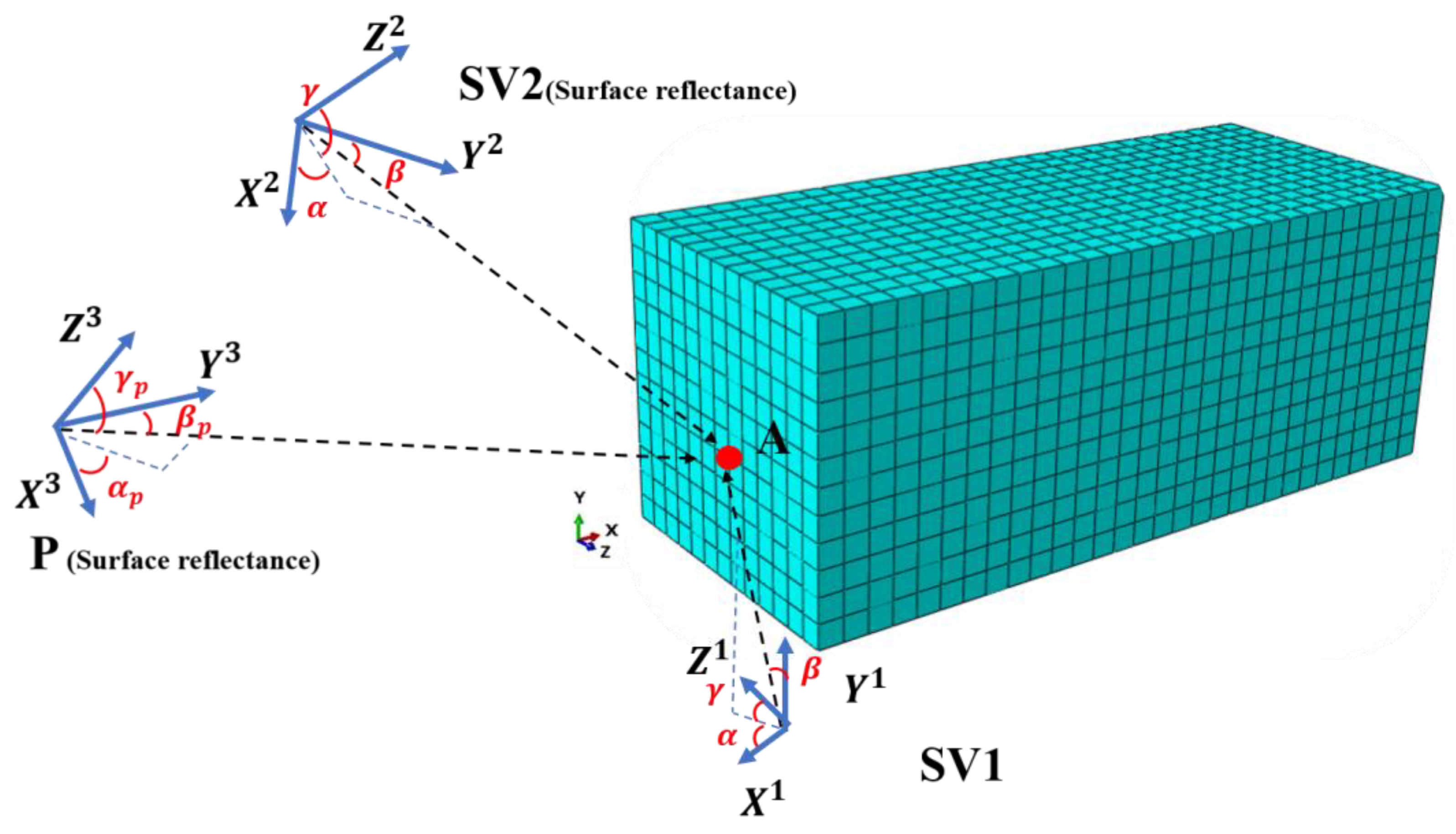
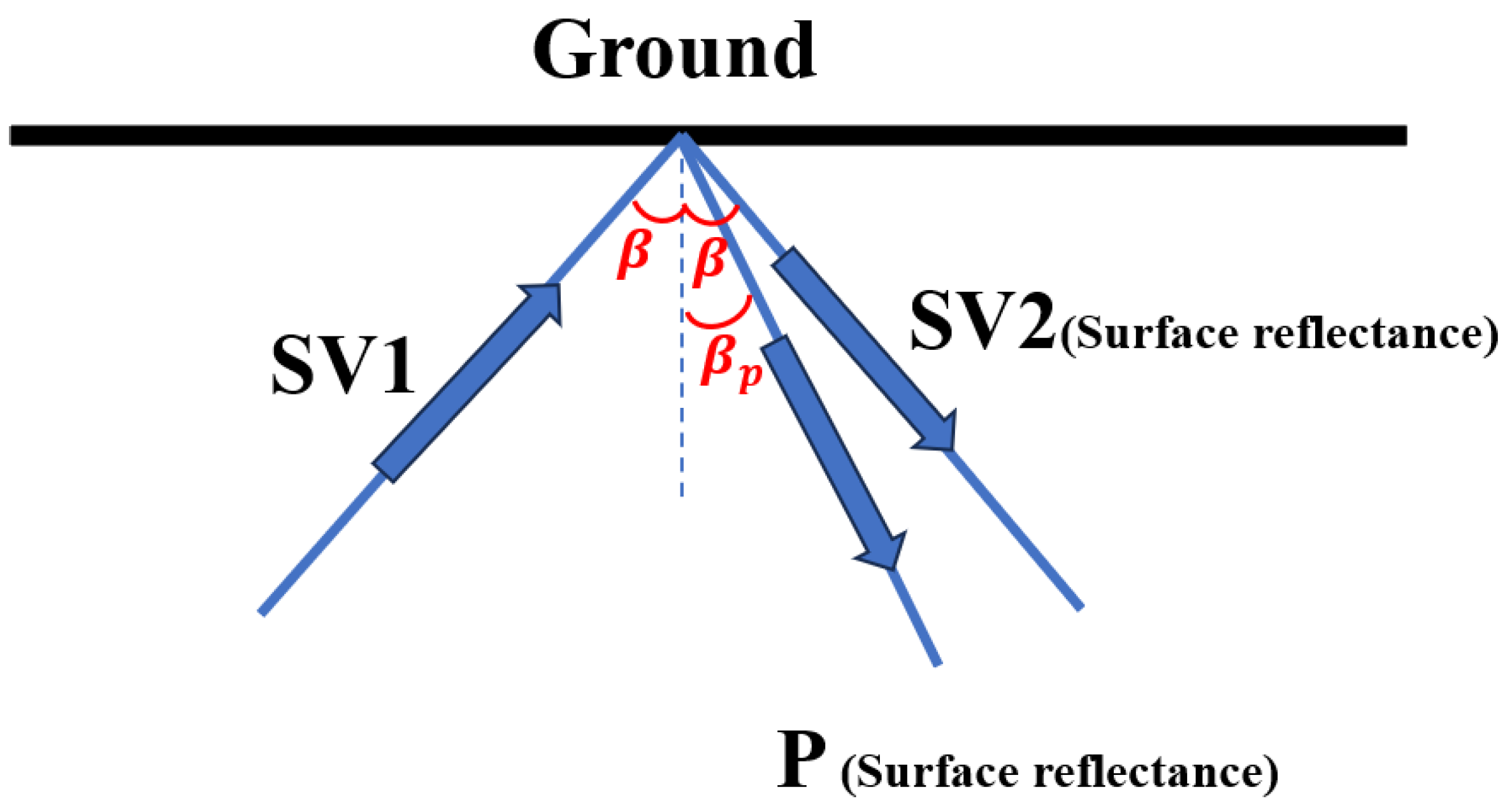

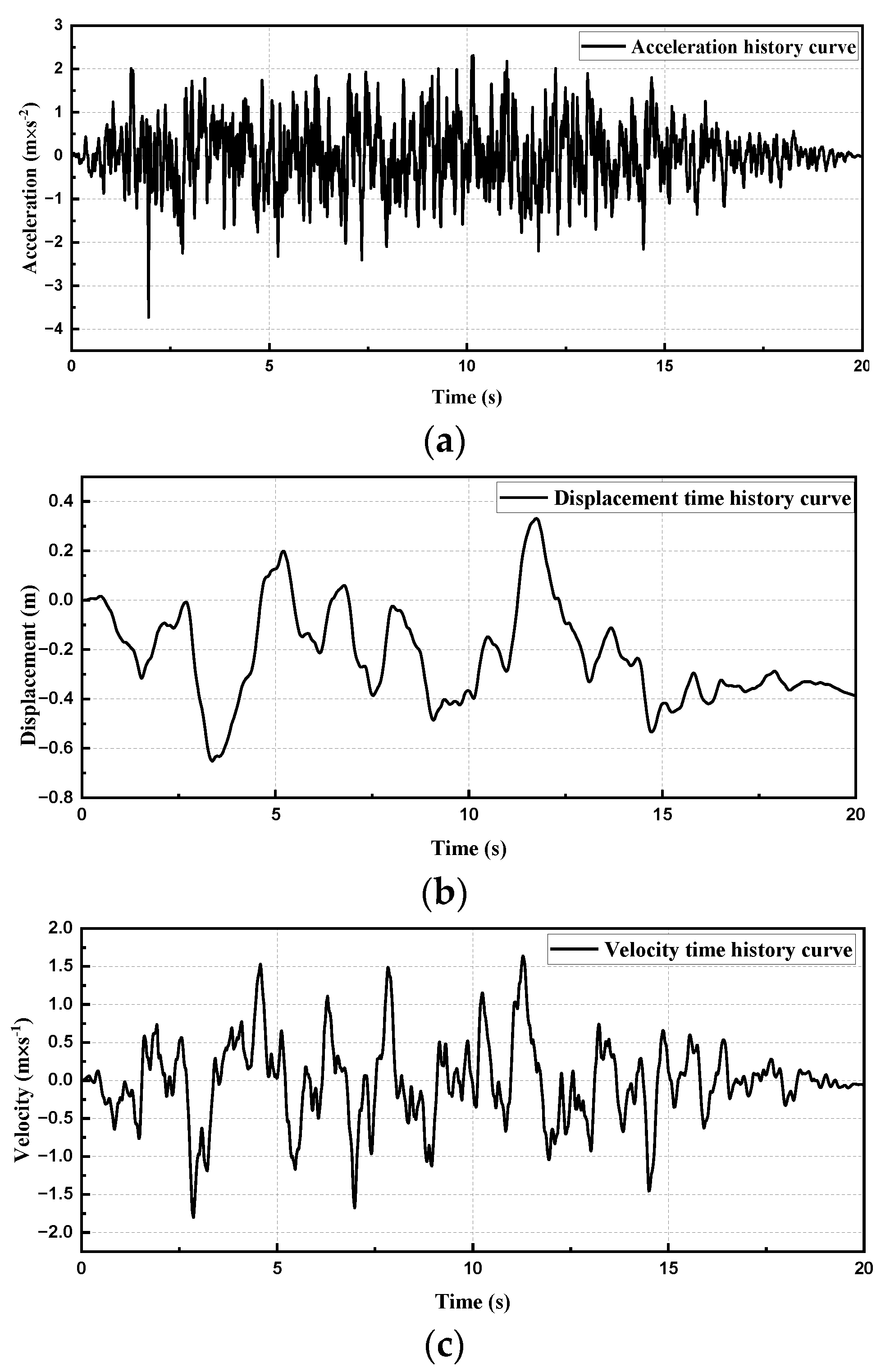
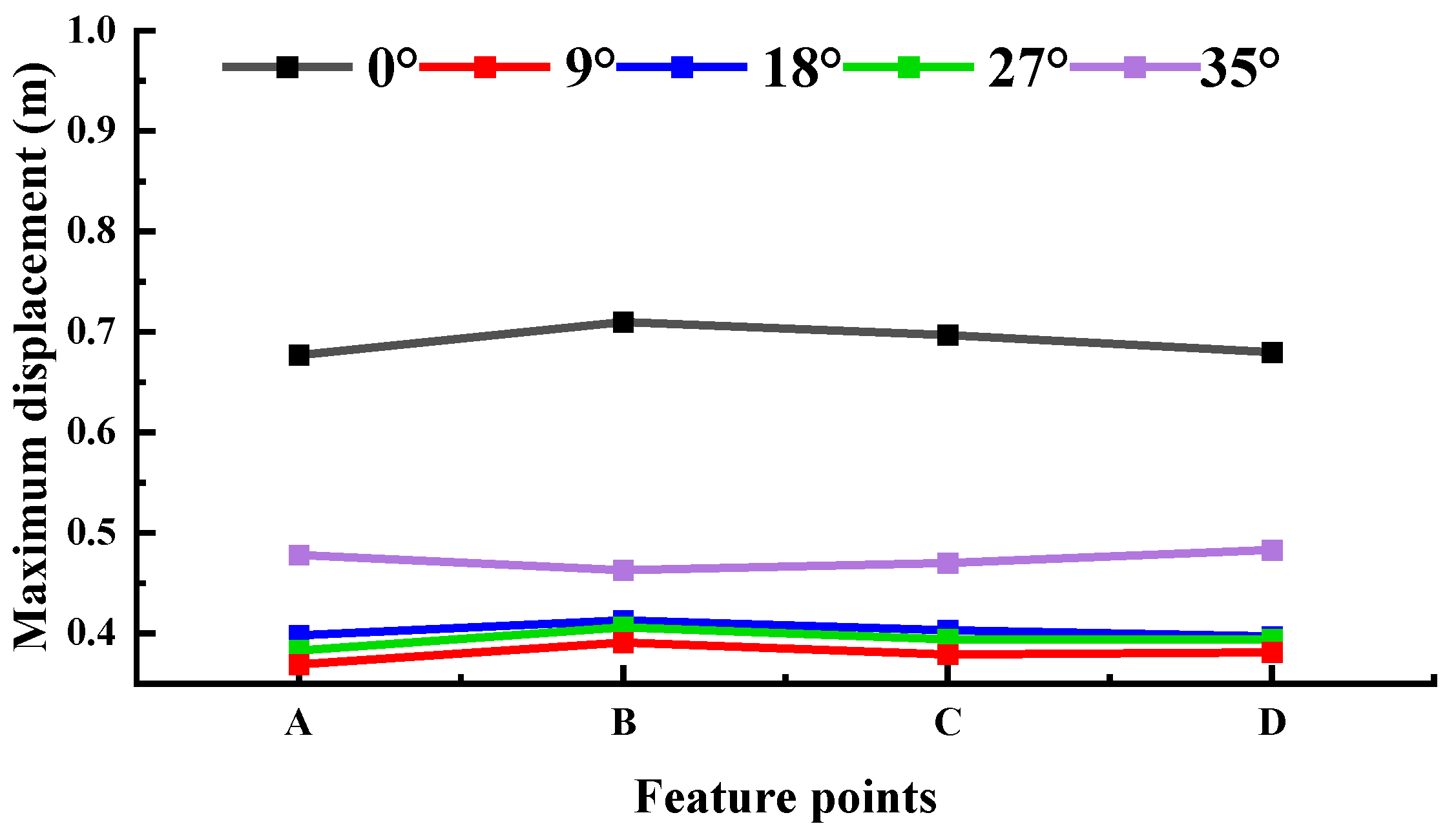
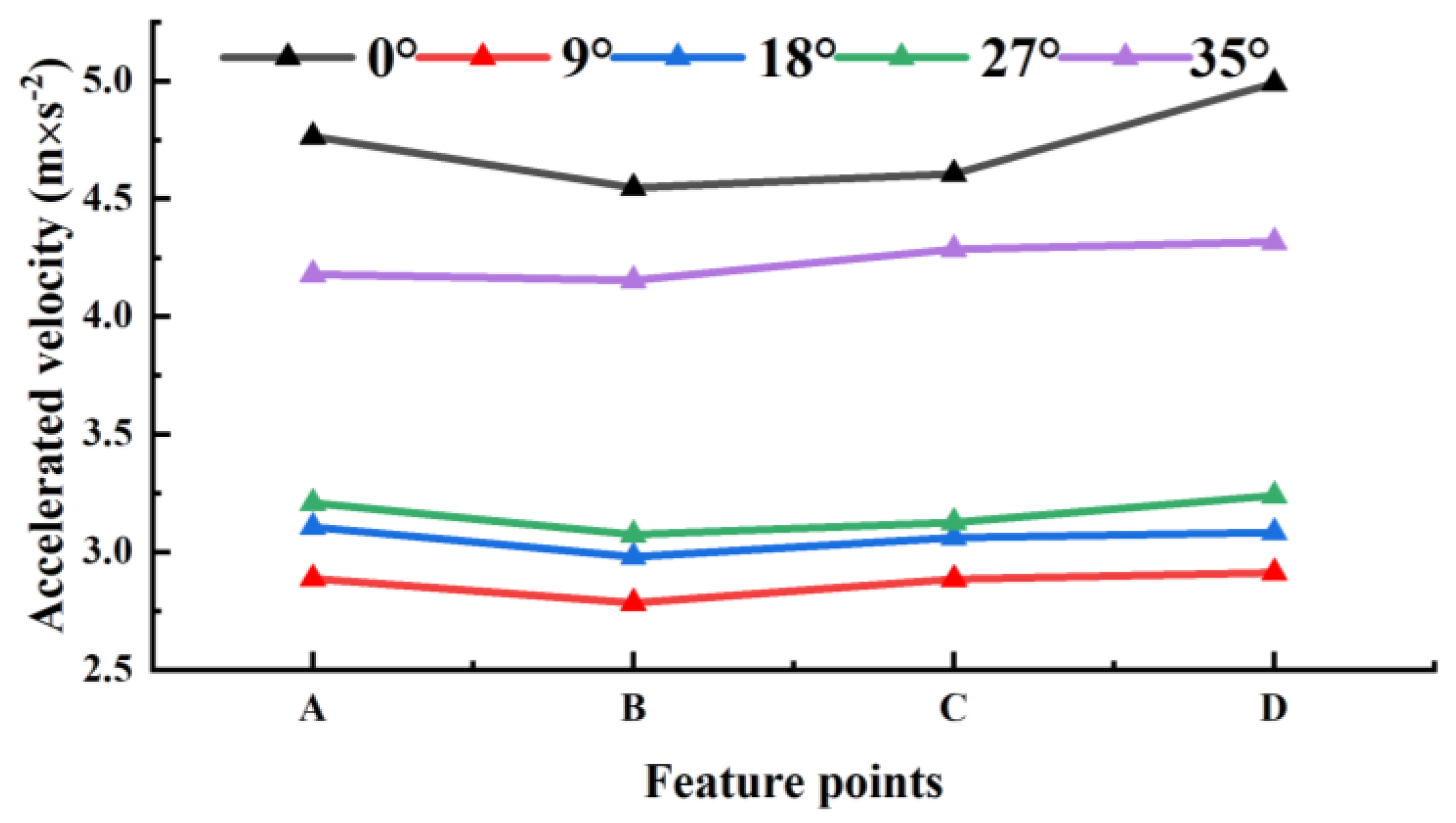
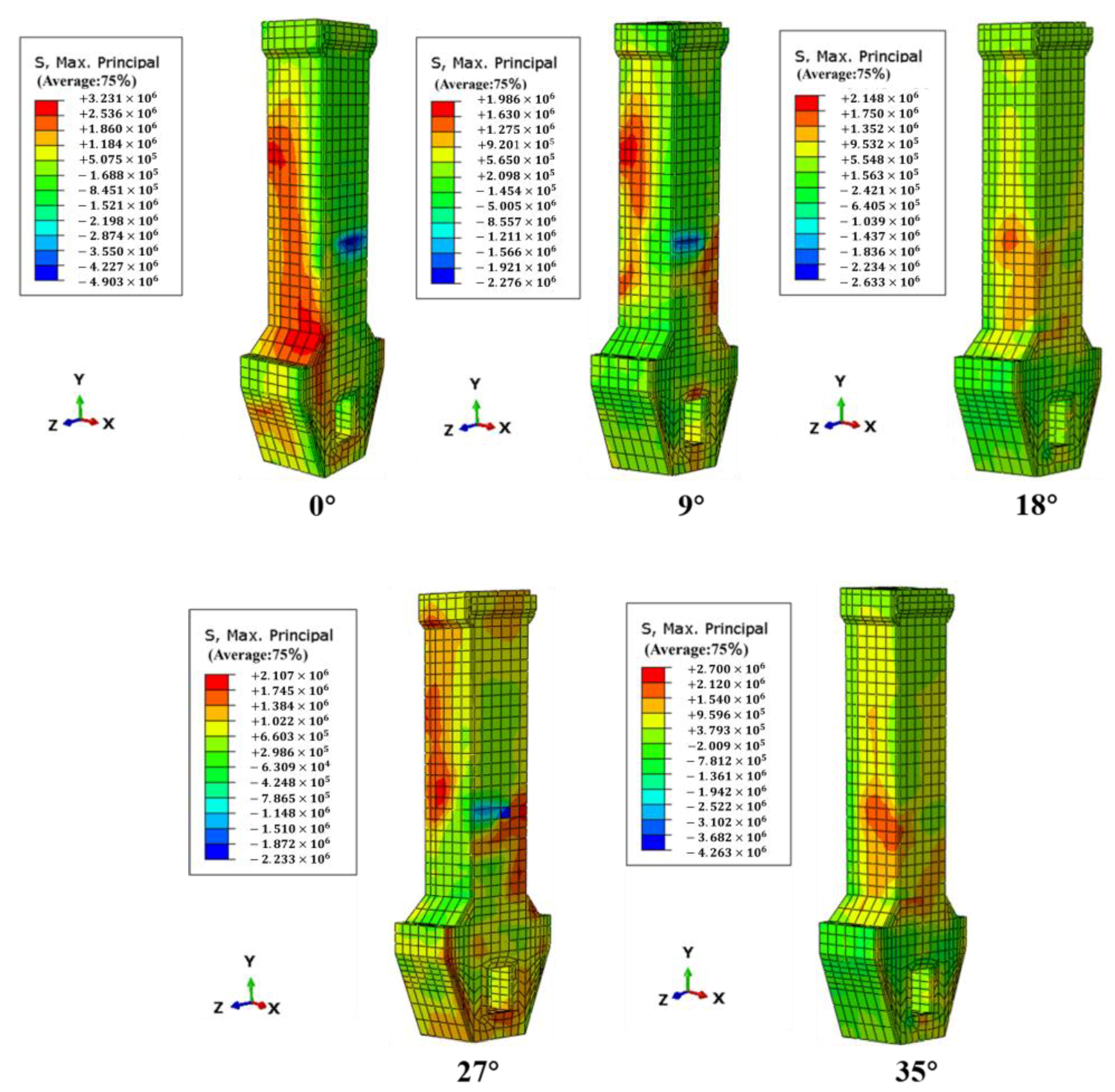

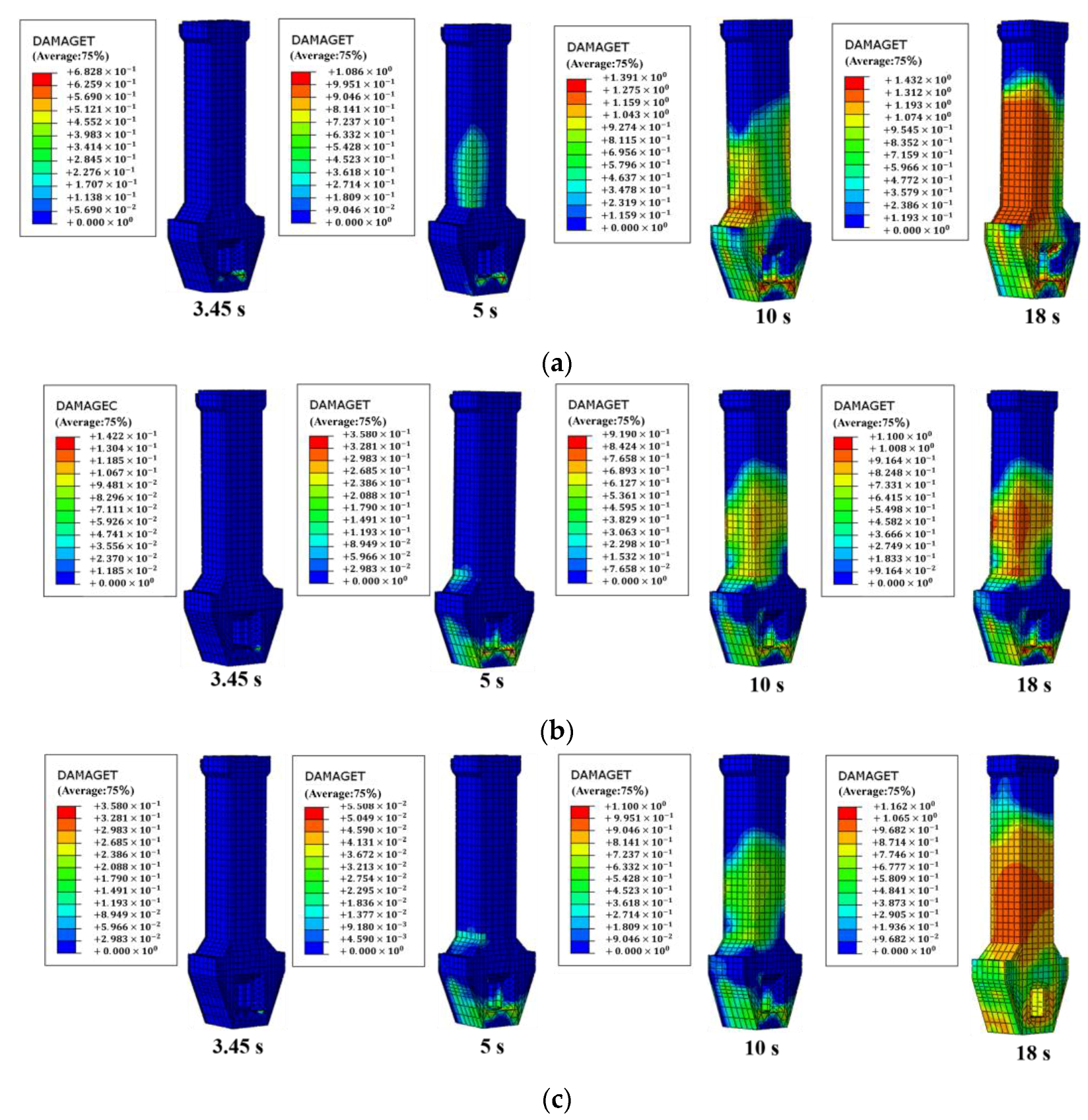
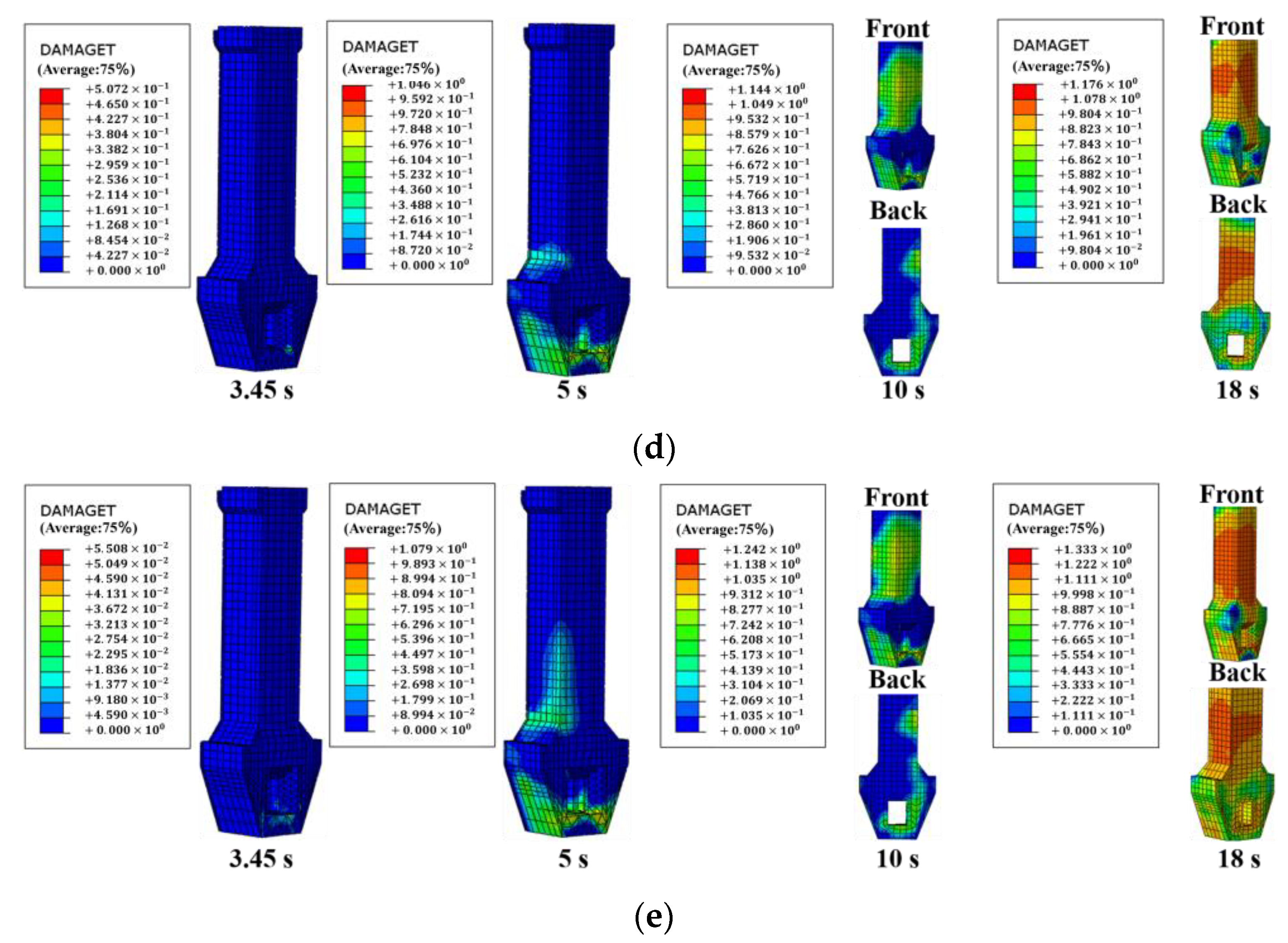
| Material | Density (kg/m3) | Elasticity Modulus (MPa) | Poisson’s Ratio |
|---|---|---|---|
| Tower body | 2500 | 2.8 × 104 | 0.167 |
| Tower base | 2500 | 3.0 × 104 | 0.167 |
| Foundation | 2720 | 1.5 × 104 | 0.2 |
| Angle (°) | Tensile Stress (MPa) | Compressive Stress (MPa) |
|---|---|---|
| 0° | 3.21 | 4.90 |
| 9° | 1.98 | 2.27 |
| 18° | 2.14 | 2.63 |
| 27° | 2.10 | 2.23 |
| 35° | 2.70 | 4.26 |
Disclaimer/Publisher’s Note: The statements, opinions and data contained in all publications are solely those of the individual author(s) and contributor(s) and not of MDPI and/or the editor(s). MDPI and/or the editor(s) disclaim responsibility for any injury to people or property resulting from any ideas, methods, instructions or products referred to in the content. |
© 2023 by the authors. Licensee MDPI, Basel, Switzerland. This article is an open access article distributed under the terms and conditions of the Creative Commons Attribution (CC BY) license (https://creativecommons.org/licenses/by/4.0/).
Share and Cite
Zheng, X.; Shen, Y.; Zong, X.; Su, H.; Zhao, X. Dynamic Response Analysis of Intake Tower-Hydrodynamic Coupling Boundary Based on SV Wave Spatial Incidence. Buildings 2023, 13, 1704. https://doi.org/10.3390/buildings13071704
Zheng X, Shen Y, Zong X, Su H, Zhao X. Dynamic Response Analysis of Intake Tower-Hydrodynamic Coupling Boundary Based on SV Wave Spatial Incidence. Buildings. 2023; 13(7):1704. https://doi.org/10.3390/buildings13071704
Chicago/Turabian StyleZheng, Xiaodong, Yiming Shen, Xingguang Zong, Hui Su, and Xun Zhao. 2023. "Dynamic Response Analysis of Intake Tower-Hydrodynamic Coupling Boundary Based on SV Wave Spatial Incidence" Buildings 13, no. 7: 1704. https://doi.org/10.3390/buildings13071704




